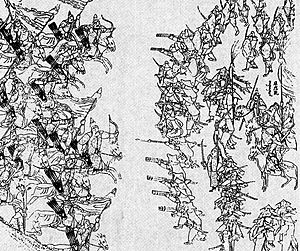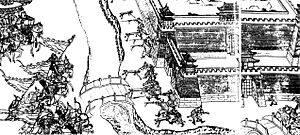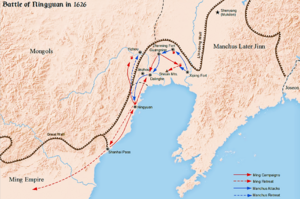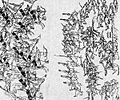Nurhaci facts for kids
Quick facts for kids Nurhaci努爾哈赤 |
|||||||||||||||||||||
|---|---|---|---|---|---|---|---|---|---|---|---|---|---|---|---|---|---|---|---|---|---|
| Khan of Great Jin | |||||||||||||||||||||
 |
|||||||||||||||||||||
| Khan of Later Jin | |||||||||||||||||||||
| Reign | 17 February 1616 – 30 September 1626 | ||||||||||||||||||||
| Successor | Hong Taiji | ||||||||||||||||||||
| Born | May 14, 1559 (嘉靖三十八年 四月 初八日) Hetu Ala, Manchuria, Ming dynasty |
||||||||||||||||||||
| Died | September 30, 1626 (aged 67) (天命十一年 八月 十一日) Aijipu, Later Jin dynasty |
||||||||||||||||||||
| Burial | Fu Mausoleum | ||||||||||||||||||||
| Consorts |
Tunggiya Hahana Jacing
(m. 1577; died 1592)Fuca Gundei
(m. 1585; died 1620)Empress Xiaocigao
(m. 1588; died 1603)Empress Xiaoliewu
(m. 1601–1626) |
||||||||||||||||||||
| Issue |
|
||||||||||||||||||||
|
|||||||||||||||||||||
| House | Aisin Gioro | ||||||||||||||||||||
| Dynasty | Later Jin | ||||||||||||||||||||
| Father | Taksi | ||||||||||||||||||||
| Mother | Empress Xuan | ||||||||||||||||||||
Nurhaci (born May 14, 1559 – died September 30, 1626) was a powerful leader of the Jurchen people. He became famous in the late 1500s in a region called Manchuria. Nurhaci was part of the House of Aisin-Gioro. He founded the Later Jin dynasty in China and ruled as its first khan from 1616 to 1626.
Nurhaci brought many Jurchen tribes together. These tribes later became known as the "Manchu". He also created a strong military system called the Eight Banners. Nurhaci started attacks against the Ming and Joseon dynasties. His victories in the Liaodong region set the stage for his descendants to conquer the Ming dynasty. They later founded the Qing dynasty in 1636. Nurhaci is also known for creating a new written language for the Manchu language. This new script was based on the Mongolian vertical script.
Contents
Understanding Nurhaci's Name and Titles
Nurhaci's name in the Manchu language is written as ᠨᡠᡵᡤᠠᠴᡳ. Some people think his name means "wild boar skin" in Manchu. Others believe it means "brave person like a wild boar." He is seen as the founder of the Qing dynasty. Because of this, he was given the special title of Taizu, which is usually given to the first rulers of new dynasties.
Nurhaci was the last chief of the Jianzhou Jurchens. He was also the first khan of the Later Jin dynasty. His title as khan in Manchu meant "brilliant khan who benefits all nations." His era name was Tianming, which means "Heaven's Mandate." After his death, he was given the name "Emperor Gao."
Nurhaci's Early Life and Rise to Power
Nurhaci was born in 1559. He belonged to the Gioro clan of the Suksuhu River tribe. Nurhaci also said he was a descendant of Mentemu, an earlier Jurchen leader. As a young man, he served as a soldier for the Ming dynasty general Li Chengliang. There, he learned Mandarin Chinese.
Nurhaci read famous Chinese novels like Romance of the Three Kingdoms and Water Margin. From these books, he learned about Chinese military and political strategies. Around 1612, he officially named his family group the Aisin Gioro clan. This was when he became the Khan of the Later Jin dynasty.
Seeking Revenge and Gaining Strength
In 1582, Nurhaci's grandfather, Giocangga, and father, Taksi, were killed. They died during a battle against a rival Jurchen chief named Nikan Wailan and Ming forces. Nurhaci wanted revenge for their deaths. The Ming dynasty returned his father's remains and gave Nurhaci trading rights. They also recognized him as Giocangga's successor.
However, the Ming refused to hand over Nikan Wailan. So, Nurhaci began to build his own power. He started with only thirteen sets of armor that he inherited from his father. In 1584, he attacked Nikan Wailan. Nikan Wailan tried to escape, but Nurhaci eventually caught him in 1587. Li Chengliang, the Ming general, finally gave Nikan Wailan to Nurhaci, who then killed him.
Over the next few years, Nurhaci grew stronger. He brought many Jianzhou Jurchen tribes under his control between 1583 and 1588. At first, Nurhaci still saw himself as a representative of the Ming emperor. He received important titles from the Ming in 1589 and 1595. He also led several trips to Beijing to pay tribute to the Ming emperor.
Uniting the Jurchen Tribes
In 1593, a group of nine tribes, led by the Yehe, attacked Nurhaci's Jianzhou Jurchens. Nurhaci's forces won this important battle, called the Battle of Gure. This victory showed his growing power.
From 1599 to 1618, Nurhaci fought against four other powerful Jurchen tribes known as the Hulun alliance. He conquered the Hada in 1603 and the Hoifa in 1607. He then defeated the Ula in 1613 and finally the Yehe in 1619 at the Battle of Sarhu. As Nurhaci's power grew, his relationship with the Ming dynasty became difficult.
Creating the Manchu Script
In 1599, Nurhaci asked two of his translators, Erdeni Baksi and Dahai Jargūci, to create a new writing system. They developed the Manchu alphabet by changing the Mongolian script. This new script helped the Manchu people communicate and record their history.
In 1606, the Mongols gave Nurhaci the title of Kundulun Khan. This showed his growing influence beyond the Jurchen tribes.
In 1616, Nurhaci declared himself the Khan and founded the Jin dynasty. This is often called the Later Jin dynasty to distinguish it from an earlier Jin dynasty. After Nurhaci's death in 1626, his son Hong Taiji renamed the dynasty to "Qing." However, Nurhaci is still considered the founder of the Qing dynasty.
To help manage his new government, Nurhaci appointed five trusted friends as his main advisors. These included Anfiyanggū, Eidu, Hūrhan, Fiongdon, and Hohori.
Invading the Ming Dynasty
In 1618, Nurhaci wrote a document called the Seven Grievances. In this document, he listed seven problems he had with the Ming dynasty's rule. This marked the beginning of his open rebellion against the Ming. Many of his complaints were about the Ming favoring the Yehe tribe over his own.
Nurhaci led many successful battles against the Ming dynasty, the Northern Yuan dynasty, and the Joseon dynasty. He also fought against other Jurchen clans. These victories greatly expanded the land he controlled.
The first capitals of Nurhaci's Later Jin dynasty were Fe Ala and Hetu Ala. Many Han Chinese people helped build Hetu Ala.
Many Ming generals and soldiers left the Ming side and joined the Manchus. These defectors played a big role in the Qing conquest of the Ming. High-ranking Ming generals who joined the Manchus often married women from Nurhaci's Aisin Gioro family. Lower-ranked defectors married other Manchu women. For example, Nurhaci arranged for one of his granddaughters to marry the Ming general Li Yongfang. Li Yongfang surrendered the city of Fushun to the Manchus in 1618.
By May 1621, Nurhaci had captured the important cities of Liaoyang and Shenyang. In April 1625, he made Shenyang his new capital city. Shenyang remained the capital until the Qing dynasty fully conquered the Ming in 1644.
Death and Lasting Legacy
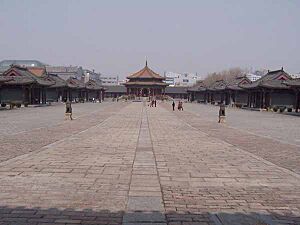
In 1626, Nurhaci faced a major defeat by the Ming general Yuan Chonghuan at the Battle of Ningyuan. This was the first serious military loss of his life. During this battle, Nurhaci was wounded by cannons made by the Portuguese, which Yuan's army used. Nurhaci could not recover from his injuries. He died two days later, on September 30, 1626, at the age of 67. His tomb, called Fu Mausoleum, is located east of Shenyang.
One of Nurhaci's most important contributions was creating the Eight Banners system. This system became the main military force of the Qing Empire. The Banners remained largely under the control of the royal family. The two elite Yellow Banners were always controlled by Nurhaci himself. The two Blue Banners were controlled by his brother Šurhaci until his death. Then, they went to Šurhaci's sons. Nurhaci's eldest son, Cuyen, controlled the White Banner for a while. Later, the White Banners were given to his grandson and his eighth son, Hong Taiji. By the end of Nurhaci's rule, Hong Taiji controlled both White Banners. The Red Banner was led by Nurhaci's second son, Daišan.
The details of how Hong Taiji became the next Khan are not fully clear. When Nurhaci died in 1626, he did not name a clear heir. Instead, he wanted his sons to rule together. Three of his sons and a nephew were the "four senior beiles" (princes). These were Daišan, Amin, Manggūltai, and Hong Taiji. The day after Nurhaci's death, they killed his main wife, Lady Abahai. She had three sons with Nurhaci: Ajige, Dorgon, and Dodo. Some historians think Nurhaci might have wanted his 15-year-old son Dorgon to be his successor, with Daišan as a temporary ruler. By killing Dorgon's mother, the princes removed a strong supporter for Dorgon.
Hong Taiji eventually became the Khan. He later changed the name of the Jurchen people to "Manchu." This change helped to create a new identity for his people.
Images for kids
See also
 In Spanish: Nurhaci para niños
In Spanish: Nurhaci para niños
- Chinese emperors family tree (late)
- Li Chengliang
- Qing conquest of the Ming
Sources
- Crossley, Pamela Kyle (1997). The Manchus. Oxford: Blackwell Publishers. ISBN 9780631235910.
- Ko, Shou-p'ing Wu (1855). Translation (by A. Wylie) of the Ts'ing wan k'e mung, a Chinese grammar of the Manchu Tartar language (by Woo Kĭh Show-ping, revised and ed. by Ching Ming-yuen Pei-ho) with intr. notes on Manchu literature. https://books.google.com/books?id=fdAOAAAAQAAJ.
Translation of the Ts'ing wan k'e mung, a Chinese grammar of the Manchu Tartar language. Shanghae: London Mission Press. 1855. http://library.umac.mo/ebooks/b31043252.pdf. - Narangoa, Li (2014). Historical Atlas of Northeast Asia, 1590-2010: Korea, Manchuria, Mongolia, Eastern Siberia. New York: Columbia University Press. ISBN 9780231160704.
- Perdue, Peter C (2009). China Marches West: The Qing Conquest of Central Eurasia (reprint ed.). Harvard University Press. ISBN 978-0674042025. https://books.google.com/books?id=J4L-_cjmSqoC.
- Peterson, Willard J. (2002). the Cambridge History of China, the Ch'ing dynasty to 1800. Cambridge University Press. ISBN 0-521-24334-3. https://books.google.com/books?id=hi2THl2FUZ4C.
- Wakeman, Frederic (1985). The Great Enterprise: The Manchu Reconstruction of Imperial Order in Seventeenth-Century China. Berkeley, Los Angeles, and London: University of California Press. ISBN 978-0-520-04804-1. https://books.google.com/books?id=8nXLwSG2O8AC. In two volumes.
- Hummel, Arthur W. Sr., ed. (1943). "Nurhaci". Eminent Chinese of the Ch'ing Period. United States Government Printing Office.
|
Nurhaci
House of Aisin-Gioro
Born: 1558 Died: 30 September 1626 |
||
| Regnal titles | ||
|---|---|---|
| Preceded by Taksi |
Chieftain of the Jianzhou Jurchens 1583–1616 |
Position abolished Manchu-led Later Jin was established in 1616 |
| New title Manchu-led Later Jin was established in 1616
|
Khan of Later Jin 1616–1626 |
Succeeded by Hong Taiji |


